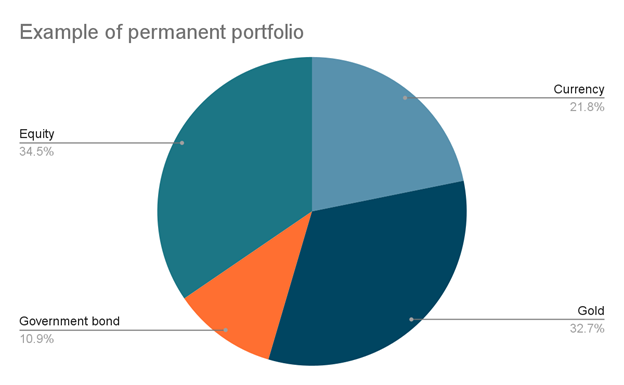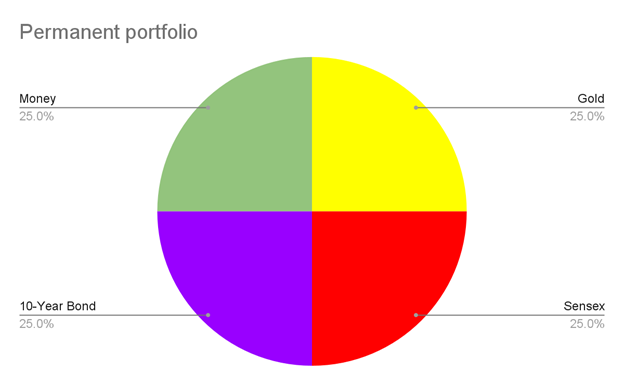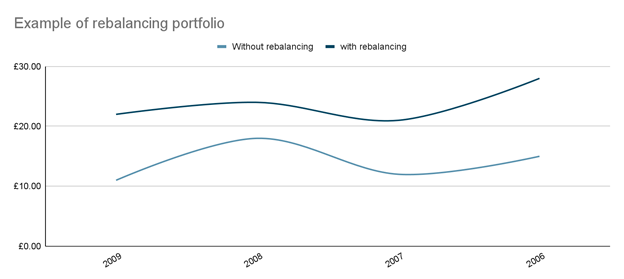Is the Permanent portfolio the best investing strategy for the average investor in 2021?

Contents
A better asset allocation is generally supposed to be an important key towards making more favorable risk-adjusted profits. There are different portfolio strategies present such as balanced portfolio strategy, bucket strategy. If you are looking for a portfolio strategy that is proving best for you, then make a permanent portfolio. Let us find more related to the permanent portfolio- the best investing strategy for an average investor!
Is a Permanent portfolio the best investing strategy for an average investor?

Harry Browne was behind the development of this strategy. He was a free-market finance analyst in the 1980s. This strategy was then designed to do very well in all the financial climates.
Harry Brown believed that the similar allotment amongst state bonds, growth shares, valuable metals, and repository or bank statements will create a complete investing combination for those investors considering growth as well as safety.
He believed that a permanent portfolio- the best investing strategy for the average investor, is best in each financial situation. This is because the growth shares would grow in weak markets, precious metals in strengthening markets, equity bonds in dropping or reflationary condition, and depository records or cash in reflation.
This portfolio plan doesn’t assist much because growth shares only count for 25% of the securities or portfolio. Except, in the situation of the decline, a permanent portfolio is a method that would lessen your deficit.
Permanent Portfolio strategy for an average investor
It relies on your targets. Risk-averse shareholders may be satisfied with yielding lower returns for more limited volatility.
For people who wish to reduce their risk, a permanent portfolio-the best-investing strategy for an average investor can be beneficial. If you evenly invest in the 4 key asset classes like equity, government bonds, gold, and money, then, you have a permanent portfolio strategy. This strategy makes it easier for shareholders to make it without getting the support of an expert adviser.

How does a permanent portfolio strategy work?
When you choose this portfolio approach you should divide your investment into equity, government bonds, gold, and money with a similar allocation, that will amount to 25% each. You should also ensure that you re-balance your investments yearly. For example, suppose that you wish to invest 100K, you will be spending 25K each in Sensex, ten-year sovereign security, gold, and money for twenty years from the year 2000-2019.

A tactical plan of the permanent portfolio
With the Permanent Portfolio approach, your investment of 100K in the year 2000 will grow to become 647K in 2019. That takes out the Compounded Annual Growth Rate (CAGR) of 9.79%, when it comes to risk. Whereas its standard deviation sets at 0.08 and downward deviation sets at 0.01. So, if we talk about the CAGR of Sensex and the ten-year sovereign security then, they are set at 10.60% and 8.09% each.
Furthermore, the downward deviation and standard deviation of Sensex held at 0.33 and 0.17, each. For the ten-year sovereign certificates, they stood at 0.04 and 0.10, each. This proves that a permanent portfolio strategy works to decrease risk and gives more favorable risk-adjusted profits. But investing in equity has offered better yields than this portfolio plan although that is a given with increased risk.
Advantages of using permanent portfolio strategy
- A permanent portfolio strategy assists in cushioning the drop in a single asset class. Also, that growth is different in similar surroundings. For instance, equity performs well when the market is in an exploding phase, but manages badly all through the recession.
- Government bonds do well all through a recession because of drops in interest rates and the growth in the prices of bonds. Although, bonds may not perform very well in economic growth. To explain, when diversified equity stocks or funds fell by 55.38% in 2008, long-term golden funds, which invest in equity securities, increased by 26.02%.
- Gold is not associated with different asset classes thus, it brings balance to the permanent portfolio. As well as safeguards it next to abrupt international events. Also, may make volatile to different asset classes.
Average return anticipations from the permanent portfolio
A permanent portfolio decreases your uncertainties in a significant way, but investors must also manage their expectations in regard to returns.
Average returns are the main reason why specialists recommend that investors should adopt more complicated tactics. Although not everyone is comfortable with complicated tactics and higher risks.
This kind of portfolio is best for shareholders who don’t know how to set up their asset allocation. Therefore, if you are not a pro in investing and are comfortable with average returns at reduced risk then the permanent portfolio plan would be a good fit.
There are 2 methods to use this tactic. You can invest 25 percent of your investible funds daily in each of the asset classes and keep adding on to the investments. This would be great for shareholders who wish to make their portfolios via daily investment plans and are not considering making asset allocation changes during the ownership of the SIPs. If you are good at investing, you can consider rebalancing your portfolio yearly.
Shareholders who do not wish to set up their portfolio can choose readymade products like (ATAF) Axis Triple Advantage Fund which funds equity, bonds, and gold in an equal way. It is important to note that these are low risk products.
Different Types of Permanent Portfolio
There are 2 kinds of Permanent Portfolios. In the first type, you invest set proportions, 25 percent in each of the 4 asset classes over a period. You may also use SIPs for this kind of investment. In the second type, you rebalance the permanent portfolio regularly.
So, when should an investor do the rebalancing?
Yearly rebalancing in the permanent portfolio
Yearly rebalancing is adequate for many portfolios, but if the shareholder is determined, he may go for a 6-month rebalancing. Yearly rebalancing is the standard, but you may also rebalance every 3 years, if the investment range is very rich.
A rebalanced trade portfolio has provided significant outcomes: a Compounded Annual Growth Rate of 12.08 percent, which is then evaluated against a non-rebalanced trade portfolio with a Compounded Annual Growth Rate of 11.48 percent. Additionally, a rebalanced trade portfolio has lower volatility in profits.

Rebalanced portfolio and standard deviation

Say, a rebalanced portfolios’ annualized standard deviation was only 7.48 thus, evaluated to 9.54 for the non-rebalanced permanent portfolio. A yearly stable permanent portfolio has performed well all through the past 15 years so, it can meet the needs of many retail shareholders. Its Compounded Annual Growth Rate of 12.08 percent can be below Sensex’s Compounded Annual Growth Rate of 13.97 percent.
Furthermore, a permanent portfolio will win if you consider the risk-adjusted profits of both. This is because the standard (regular) deviation of a permanent portfolio is very weak, i.e., 7.48, assessed to that of the Sensex—24.35. At last, when the prospect of a permanent portfolio offers the comfort of investing, you may not be thoughtless.
Shareholders need to be attentive to the selection of the goods in every asset class, or otherwise rebalancing would be tough. Thus, on the securities side, one requires to avoid investing in products like EPF, PPF, etc. that occur with conditional clauses.
Does rebalancing ever improve returns?
Sigma Research completed a study on the impact of portfolio rebalancing from 1975 to 2004. Research has found that rebalancing sometimes outperforms floating portfolios, and sometimes not.
The investment portfolio considered covers the 30-year period from 1975 to 2004 and includes:
- 40% Large US Stocks
- 20% International Stocks
- 20% Emerging Marketing Stocks
- 20% US Equity
The results show that there are significant gains in rebalancing across all time frames. However, a closer look at the underlying data shows that the two most important characteristics required for “rebalancing bonds” have been met.
Asset classes are generally not relevant. The average rate of return for each asset class is within a very narrow range (9% to 10.7%). The differences between individual asset classes are large (the standard deviation for emerging markets is 40%.
| Balanced | Rebalanced | |||
| Annual return | Standard deviation | Actual return | Standard deviation | |
| 30 Years | 11.3% | 14.4% | 10.0% | 13.8% |
| 20 Years | 12.9% | 13.9% | 11.6% | 12.9% |
| 10 Years | 10.8% | 9.9% | 9.6% | 9.4% |
Know how to create a permanent portfolio
There are various techniques by which an investor can develop a permanent portfolio depending on the number of investing opportunities available. Here is one recommendation on how to get a balanced mix.
25 percent in U.S. shares, to give a powerful return in times of success. For this part of the portfolio, Harry Browne suggests a fundamental fund in the S & P 500 index like VFINX or the Vanguard 500 Index Fund.
25 percent in lifelong US Treasury bonds, which do very well in successful periods and during deflation.
25 percent in money to hedge next to periods of tight cash or recession. In this regard, cash would be small-term Treasury bills of the US.
25 percent in valuable metals(gold is a perfect choice) to give safety when there is inflation. Harry Browne suggests gold bullion coins.
Browne suggests rebalancing the permanent portfolio once a year to keep up the 25% target masses.
How is asset allocation done in the permanent portfolio?

Gold, shares, and bonds are unstable assets but can shift separately. The economic situations would cause their changes.
Harry Browne recommends rebalancing yearly to make sure your asset allocation flows and manages its capability.
A plus or minus 5% to 10% rebalancing ring is a common tactic used when doing it yourself. Moving the band’s threshold ahead activates a rebalancing effect.
For instance, when employing a plus or minus 5% rebalancing ring, you would rebalance anytime the permanent portfolio shifted above or below five percent of its target.
CONCLUSION
A permanent portfolio is the best investing strategy for an average investor
There is no ideal portfolio, but everybody looks for it. If you are a risk-averse shareholder and worried more about saving capital try to set up a Permanent Portfolio- the best investing strategy for an average investor.
The stock market poses high risk. Always discuss investments with an approved financial planner before making any significant financial decisions. Data is power, but it is beneficial to recognize the numbers.
Article Disclaimer
